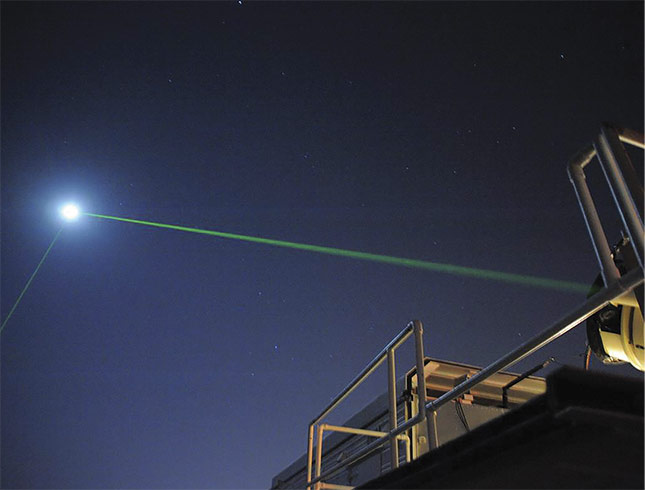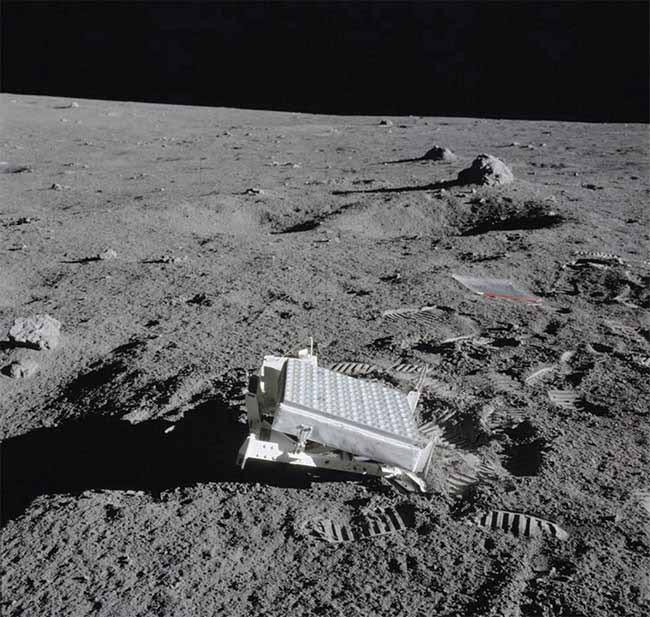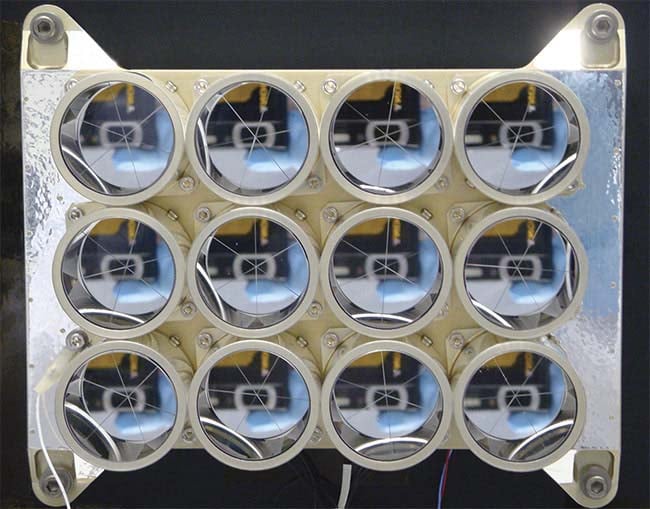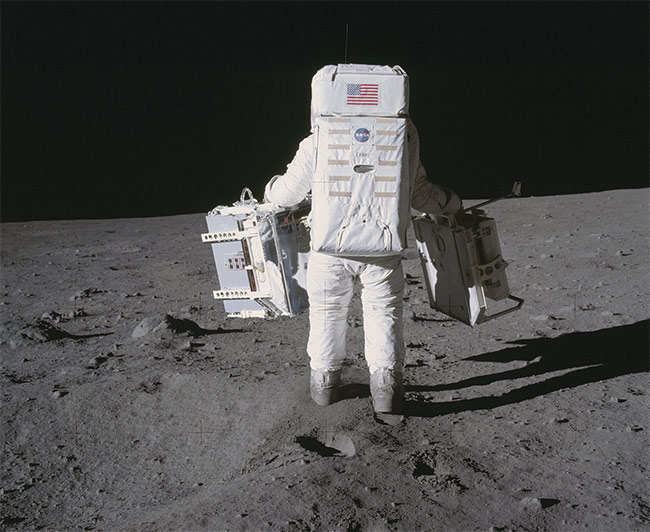Extensively in the last 50 years, intermittently in the last decade, and with newfound success in receiving a return
on their efforts this past summer, NASA
scientists have taken aim at the moon with high-power laser beams. Receiving even a faint signal back from the moon is a stark improbability: NASA estimates that a photon launched from Earth has about a 1-in-25-million chance of reaching the Apollo 11 reflector, which has been on the moon since 1969.
The successfully acquired return signals have held considerable value. Just clocking the response time that it takes light sent from Earth to return from the moon has yielded important insights into Earth’s relationship with its nearest neighbor. These include the realization that the distance between the two bodies is widening and that the drift is happening at a rate of ~1.5 in. per year.

A return of even 200 photons, out of tens of thousands of potential photons, from a reflector array on a spacecraft in orbit charts a course for planetary scientists to resolve questions about the makeup of the moon’s interior, and why existing surface reflectors are delivering poor returns. Courtesy of NASA.
In a planetary laser-ranging first, a team from NASA’s Goddard Space Flight Center in Greenbelt, Md., partnering with a team from Géoazur at the Université Côte d’Azur in France, received a return of photons — about 200 in total, out of tens of thousands of pulses — from a reflector mounted on the Lunar Reconnaissance Orbiter (LRO). The experiment marked the first successful return from a reflector array on an orbiting spacecraft. Though the response was a weak one, the fact that photons could reach the orbiter was a long-elusive triumph. Variations
on this laser-ranging experiment have been ongoing since the Apollo era. Though the Apollo-era surface reflectors that are capturing and returning photonic signals from the moon are more than
50 years old, scientists have relied on them to determine not only that Earth and the moon are drifting apart, but to gain more elaborate information, including the fact that the moon has a liquid core.
After NASA received returns from LRO’s reflector on four passes in 2018 and 2019, new doors opened up for acquiring data and for laying the groundwork for future and forthcoming experiments.
At the same time, new questions have arisen. Among them is why the Apollo-era reflectors deliver poorer photonic returns than expected. Quantifying the disparity between optical returns from LRO’s reflector and those from Apollo-era reflectors would significantly help planetary scientists answer this question.
With a newly proven method in their arsenal, NASA scientists could next
enhance the method’s reliance on laser ranging to perform distance measurements, as well as to collect information that would be beneficial to optimizing how those measurements are carried out.
Infrared advantages
The NASA and Géoazur collaborators based their operation at a laser station in Grasse, France, using a telescope with the ability to pulse an infrared light wavelength at LRO.
“Laser ranging to a distant, fast-moving target is by itself an extremely challenging task,” said Vishnu Viswanathan, a
scientist visiting Goddard from the
University of Maryland, Baltimore County and its Center for Research and Exploration in Space Science and Technology. Even lining up a telescope to its target at a laser station is a challenge. As a laser is fired through a telescope, Earth’s atmosphere disperses the beam, and only a fraction of the beam arrives at the reflector array. On its way back to Earth, it is further distorted by factors including atmospheric conditions.
NASA scientists working at Grasse said they do not know the full extent to which the beams in the current experiment were distorted, beyond the beam broadening past its inherent angle of divergence. What they do know is that the atmosphere has a far greater influence on the uplink beam than the downlink beam. This effect, said research team member Xiaoli Sun from Goddard, is more severe at shorter wavelengths.

Surface reflectors, situated on the moon’s surface for more than 50 years, may now be covered with
lunar dust. NASA scientists are aiming to confirm this upon receiving a return of photons from the Lunar Reconnaissance Orbiter (LRO). Courtesy of NASA.

A close-up of the Lunar Ranging Array, following its installation at NASA’s Goddard Space Flight Station. Courtesy of Xiaoli Sun.
The benefit of working from Grasse is twofold. It is the most active of the lunar laser-ranging (LLR) ground stations and is typically capable of obtaining ranges to multiple Apollo and Lunokhod (Soviet) surface arrays in a single night. Also, the Grasse station’s infrared wavelength laser penetrates Earth’s atmosphere more effectively than the more widely available visible green-light-wavelength lasers scientists have traditionally relied on for laser ranging.
In the undertaking, scientists at the Grasse station used a custom InGaAs/InP single-photon avalanche diode (SPAD) as a detector with high sensitivity and a low dark count rate.
“In 2017, the Grasse group reported the benefits of using infrared (1064 nm) over the traditional green (532 nm) wavelength for satellite and lunar laser-ranging operations,” Viswanathan said. “This improves the atmospheric transmission of photons and enhances the signal returned despite the wider diffraction angle. This also improved our odds of obtaining returns from the LRO spacecraft.”
In the past, the high-performance
single-photon counting detectors on which laser-ranging scientists have relied have operated at visible wavelengths, Sun said. “There is an advantage to using shorter-wavelength lasers for ranging, since the inherent laser beam divergence angle (in a vacuum) is proportional to the laser wavelength. Now, the most mature and convenient lasers to use for satellite laser ranging are Q-switched neodymium-doped yttrium aluminum garnet lasers, which emit at 1064-nm wavelength.”
As single-photon detection has evolved, detectors operating in the near-infrared have encouraged expanded attempts.
For these experiments, Sun said, the lasers must have a short pulse width (less than 100 ps) and high pulse energy (hundreds of mJ/pulse). “Most ground stations around the world currently use 532-nm wavelength solid-state lasers with a frequency-doubling crystal because of the availability of the photon-counting receivers. The Grasse station is one of the few ground stations that can also use the 1064-nm wavelength for lunar laser ranging.”
Laser pulse width binds the ranging precision, or the specific photon arrival time. This explains why laser-ranging stations have used — and largely continue to use — short-pulse lasers: The shorter the pulse width, the better the range precision.
Because a laser beam diverges as it propagates, even in a vacuum, the team needed high pulse energy for its experiment. The divergence angle is proportional to the laser wavelength divided by the collimated size of the laser beam. The width of a laser beam coming from Grasse grows to a few kilometers by the time it reaches the moon. The retroreflector array only intercepted a small portion of that beam, which is what is ultimately reflected back to Earth.
The LRO array is the smallest to successfully return signals from lunar distances. Its size and mass make it potentially suitable for future lunar landers.
Long-term applications
Five reflecting panels currently reside on the surface of the moon, each made of an array of mirrors called corner cubes. Despite the panels’ ability to reflect light back in any direction, dust coverage is one vulnerability they cannot overcome — at least not on their own. Some experts attribute poor light returns from the Apollo-era surface reflectors to the likelihood that they are covered with 50 years’ worth of lunar dust. This was one of the questions NASA hoped to answer via signals returned from LRO’s reflector.
“In our present results, we compared the rates of photons returned from laser ranging to the Apollo-era surface reflectors and the reflectors onboard LRO,” team member Erwan Mazarico told Photonics Media. “The LRO reflector array being in orbit is expected to have remained pristine over the past 11 years of its operation. On the other hand, the reflectors that have been on the lunar surface for 50 years are now subjected to the lunar dust environment. Comparison between them helped us calibrate our return photon rates to what we could expect about the dust accumulation on the reflectors since the Apollo era.”
Having LRO gauge light returns was not in NASA’s plans when the organization conceived of the spacecraft that it sent into orbit around the moon in 2009.
“LRO carried reflectors on board to help understand the nature of dust accumulation and transport on the lunar surface,” Mazarico said. “It was not in the initial design of the spacecraft and was added during the LRO development. It made use of the mounting screw holes of another spacecraft component that was descoped.”
As a result, the reflector array is in an unconventional location on the spacecraft, and the high-gain antenna causes some obscuration, ultimately making laser ranging more difficult, Mazarico said.
NASA has yet to definitively rule on the presence of dust on the Apollo-era reflectors, despite coming closer to achieving this task by scrutinizing the differences in the physical conditions between the LRO and Apollo reflectors, taking into account their respective number of years in service. Through the Commercial Lunar Payload Services program, NASA is funding next-generation single-cube reflectors that upcoming commercial
missions will be expected to carry.
These missions are scheduled to commence in 2022.
“We are also considering other approaches, such as laser ranging, where you would have an active laser transponder on the lunar surface, capable of receiving and transmitting one-way laser pulses from/to a regular Earth laser-
ranging station to obtain range information. This would greatly improve the efficiency of the experiment,” Mazarico said.
Though such a revision to the experiment would bring its own set of challenges, one benefit of the team’s recent success involves the correlation between the effectiveness of infrared light and the potential for future measurements. The demonstrated precision of infrared measurements may be what ultimately leads to additional and improved reflectors landing on the moon.
From there, the ability to answer questions intensifies, as do the possible questions themselves. Laser experiments could reveal solid material within the moon’s core, which, as scientists have ascertained from previous experiments, has a liquid base.
Beyond inching closer to resolving the lunar dust mystery, the success of the NASA/Géoazur experiment validates
the application of infrared light and its place in forthcoming laser-ranging undertakings.

NASA’s Apollo-era technology on the moon’s surface has allowed the agency to conclude that Earth and the moon are actively drifting apart, and to determine the rate at which they are separating. Courtesy of NASA Johnson Space Flight Center.
“More ground stations able to conduct LLR observations would improve the geometric strength and contribute to the scientific utility of the existing LLR data sets,” Viswanathan said. Using infrared light would help stations with smaller-
aperture telescopes improve their odds
of a successful lunar ranging experiment.
“We expect this will promote the expansion of the lunar laser-ranging network, currently limited to four stations contributing high-precision data, all in the Northern Hemisphere.”
The NASA team has worked with a Grasse station group since 2017, weathering challenges and situations brought on by, among other things, weather itself.
The team said LLR would benefit from a wider, better-distributed network of stations around the world, similar to the satellite laser-ranging network. New
stations in the Southern Hemisphere would especially have potential to yield results and information by increasing the uniformity of lunar observations.